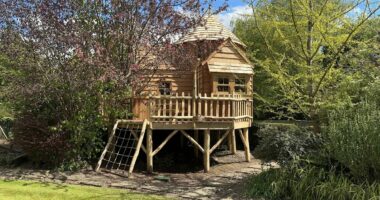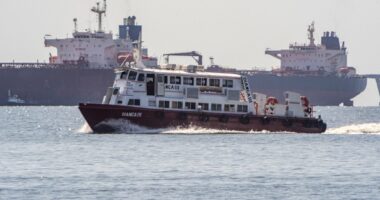Share this @internewscast.com
Alaska’s capital city experienced severe flooding and unprecedented water levels following the rupture of an ice dam at a nearby glacier, which unleashed a tremendous flow of rainwater combined with snowmelt.
The Mendenhall River overflowed earlier in the day, sending water into streets and some residential yards of Juneau on Wednesday.
Some residents were able to return to their home while other areas remained ‘closed until further notice.’
The Juneau city website issued a warning advising residents to exercise extreme caution around damaged structures, steer clear of riverbanks, and refrain from driving through flooded areas.
‘Officials warn that driving through flooded areas can create damaging waves that further impact nearby buildings.’
Thanks to newly installed flood barriers, constructed earlier this year to protect the community from potential threats posed by glaciers, the area avoided further damage from the flooding.
“They truly safeguarded our community,” remarked Juneau City Manager Katie Koester during a press briefing. “Without them, we would’ve faced hundreds of flooded residences.”

On Tuesday, Alaskans had to leave their homes when the Mendenhall River was inundated, causing hazardous floodwaters and debris to impact nearby areas. Depicted: The aftermath of flooding from glacier water and snowmelt at Mendenhall Glacier on August 13, 2025, in Juneau, Alaska.

Numerous roads in the area were shut, including Mendenhall Loop Road, which will remain closed until water levels recede below 12 feet and safety checks are completed. Depicted: Flooding from glacier water and snowmelt at Mendenhall Glacier enveloped roads and posed a threat to homes along the Mendenhall River in Juneau, Alaska.
City officials responded to concerns from property owners this year by working with state, federal and tribal entities to install a temporary levee along roughly 2.5 miles of riverbank in an attempt to guard against widespread flooding.
The 10,000 ‘Hesco’ barriers are essentially giant, reinforced sandbags intended to protect more than 460 properties, said emergency manager Ryan O’Shaughnessy, The Associated Press reported.
The Juneau Assembly required homeowners in the flood zone to cover 40 percent of the cost – amounting to about $6,300 each over 10 years.
Additionally, a handful of homeowners were asked to chip in $50,000 toward reinforcing the river bank.
Only about one-quarter of the residents formally objected, not enough to call quits on the project.
While flooding did occur, the impacts were far less severe than those seen in 2023 and 2024, when nearly 300 homes were inundated during similar glacial outburst events.
The devastating flooding began after water from Suicide Basin – a side basin of the Mendenhall Glacier, located about 10 miles above the state’s capital – broke free, inundating roads, damaging infrastructure, and prompting emergency warnings.
‘A glacial outburst has occurred at Suicide Basin,’ officials wrote in a statement on Tuesday afternoon.
‘The basin is releasing and flooding is expected along the Mendenhall Lake and River late Tuesday through Wednesday.’
City officials urged residents living within the 17-foot lake level inundation zone to evacuate the area immediately, adding that when the area is deemed ‘all clear,’ a wireless emergency alert will be sent to residents, Fox4 News reported.
Roads across the region were closed, including Mendenhall Loop Road, which will remain off-limits until water levels drop below 12 feet and safety inspections are complete.

City officials urged residents living within the 17-foot lake level inundation zone to evacuate the area immediately. Pictured: The engorged Mendenhall River flowing through Juneau, Alaska, on August 13, 2025

The devastating flooding began after water from Suicide Basin – a side basin of the Mendenhall Glacier, located about 10 miles above the state’s capital – broke free

The destructive flooding was triggered by a glacial lake outburst flood (GLOF), a type of event that occurs when water dammed behind glacial ice or debris is suddenly released. Pictured: Flooding from a release of water and snowmelt at Mendenhall Glacier on Augusr 13, 2025 in Juneau, Alaska
In addition, multiple public facilities along the overflowing river, including the Mendenhall Valley Public Library and the Diamond Park Aquatic Center, were shut down.
The Federal Aviation Administration has also issued a temporary flight restriction over the area to ensure safety for aerial flood monitoring and response.
‘This TFR creates controlled airspace to ensure safe aerial operations for geo-hazard monitoring, flood response, and potential evacuations,’ the Alaska Department of Transportation & Public Facilities said.
The National Weather Service (NWS) has also issued a flood warning for the Mendenhall River, where water levels topped 16 feet early Wednesday – surpassing last year’s record crest of 15.99 feet.
‘Our forecast right now… we’re thinking our crest might be closer to 8 in the morning and might be closer to the higher end of the spectrum,’ Andrew Park, a meteorologist with the NWS Juneau office, said.
‘This will be a new record, based on all of the information that we have,’ NWS meteorologist Nicole Ferrin added during a Tuesday press conference.
Experts are now warning local residents not to approach the water.
‘There is a lot of debris in the river. Please stay away from the river. It’s very dangerous right now,’ Park added, explaining, ‘if you get in that water, you’re not going to make it out of there.’
The destructive flooding was triggered by a glacial lake outburst flood (GLOF), a type of event that occurs when water dammed behind glacial ice or debris is suddenly released.
The U.S. Geological Survey (USGS) describes GLOFs as unpredictable, warning they have caused ‘significant loss of life and infrastructure worldwide.’
Suicide Basin – named for the constant avalanches of ice that occur from the hanging glacier above it – has released glacial floodwaters annually since 2011, with record-breaking floods reported in both 2023 and 2024.

The U.S. Geological Survey (USGS) describes GLOFs as unpredictable, warning they have caused ‘significant loss of life and infrastructure worldwide.’ Pictured: The Suicide Basin before the glacial lake outburst flooding from the Mendenhall Glacier

Officials predict that the volume of water being released from the basin during recent events is increasing – a trend scientists link to climate change. Pictured: The Suicide Basin during the glacial lake outburst flooding on August 12, 2025
However now, officials predict that the volume of water being released from the basin during recent events is increasing – a trend scientists link to climate change.
The Juneau city website compares the process of a glacial lake outburst to ‘pulling the plug from a full bathtub.
‘When the basin fills with meltwater and rainfall, it can suddenly breach the ice dam, sending torrents of water downhill.
As global temperatures continue to rise, devastating weather events, like the powerful flood waters seen in Alaska this week, are expected to become more common.
According to NOAA, Alaska has warmed twice as fast as the rest of the U.S., with average annual temperatures rising 3.1 degrees Fahrenheit over the last century, and as glaciers retreat, meltwater collects in unstable basins, increasing the risk of sudden floods.
A 2019 study found the world’s glaciers are losing up to 390 billion tons of ice and snow each year, with Alaska’s glaciers contributing significantly, USA Today reported.















